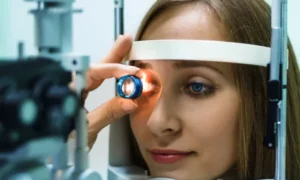Considering Refractive Lens Exchange (RLE) surgery? Before you dive in, it’s essential to understand the groundwork. Just like you wouldn’t buy a pair of shoes without trying them on, you wouldn’t want to undergo a surgical procedure without the right evaluations. In this guide, we’ll unravel the essential eye tests required before RLE surgery, ensuring your eyes are primed and ready for a successful outcome. From measuring your sight to closely examining your eye’s intricate structures, let’s explore the comprehensive steps that pave the way for clearer vision.
Contents
The Importance of Eye Testing Before RLE Surgery
 Before delving into any surgical procedure, especially one as vital as RLE, understanding the current status of your eyes is paramount. Why, you might wonder?
Before delving into any surgical procedure, especially one as vital as RLE, understanding the current status of your eyes is paramount. Why, you might wonder?
- Ensuring Suitability
Not every individual is a suitable candidate for RLE. These evaluations help in identifying whether your eyes are fit for the surgery or if there are potential underlying issues that might contraindicate the procedure. - Tailoring the Surgery
Every eye is unique. Pre-RLE tests provide detailed insights, allowing surgeons to customize the surgery according to the specific needs of your eyes, ensuring optimum results. - Anticipating and Avoiding Complications
Detecting possible risks beforehand is a cornerstone of medical prudence. These tests can uncover issues that might lead to complications during or after the surgery. Identifying them early on means they can be addressed, ensuring a smoother surgical process and recovery. - Establishing a Baseline
It’s essential to understand the initial state of your eyes. This “baseline” data aids in post-surgery evaluations, ensuring that the desired results have been achieved and that your vision is on the right track.
In essence, while eager anticipation for clearer vision is understandable, it’s the diligent, thorough pre-surgery evaluations that lay the foundation for a successful RLE outcome, safeguarding both your eyes’ health and your overall well-being.
What Tests Are Done Before RLE Surgery?
When considering RLE surgery, it’s crucial to undergo a series of comprehensive tests to ensure the safety and success of the procedure. Let’s explore these essential assessments in detail.
Visual Acuity Test: Measuring Your Sight
 The Visual Acuity Test is a primary eye examination that gives an initial measure of your vision’s clarity. It is fundamental for every eye surgery evaluation, RLE included.
The Visual Acuity Test is a primary eye examination that gives an initial measure of your vision’s clarity. It is fundamental for every eye surgery evaluation, RLE included.
- Purpose: The primary goal of this test is to determine how clearly each eye can see. It’s a foundational assessment that helps gauge the existing state of your vision.
- How It Works: During this test, you’ll be asked to read letters or symbols of varying sizes on an eye chart, usually placed at a standard distance of 20 feet. You’ll start with larger letters at the top, progressing to smaller rows until the letters become too challenging to read clearly.
- Results Interpretation: The results are typically denoted as a fraction, such as 20/20, 20/40, etc. The top number represents the distance you stand from the chart, and the bottom number indicates the distance at which a person with average vision can read the same line you correctly read. For instance, if your vision is 20/40, it means that you must be as close as 20 feet to see what a person with normal vision can see at 40 feet.
- Significance for RLE: Understanding your current level of vision is essential for the surgeon to gauge the potential benefits of RLE for you. A drastic deviation from normal vision may indicate underlying issues that require additional investigations or treatments.
While this is just one of the many tests, it plays a pivotal role in forming a holistic understanding of your eye’s condition and ensuring you get the best possible outcome from your RLE surgery.
Slit Lamp Examination: A Closer Look
 Surgeons perform the Slit Lamp Examination to get a detailed view of the structures inside your eyes. It offers critical insights that a basic visual acuity test can’t provide.
Surgeons perform the Slit Lamp Examination to get a detailed view of the structures inside your eyes. It offers critical insights that a basic visual acuity test can’t provide.
- Purpose: This examination aims to closely inspect various parts of your eye, especially the front structures like the cornea, iris, and lens. It can help identify a range of conditions, from common ones like cataracts to more intricate issues that could affect the success of RLE surgery.
- How It Works: A slit lamp is a specialized microscope designed for eye examinations. It shines a thin sheet of light (or a “slit”) onto your eye. As the patient, you’ll rest your chin and forehead on a support to keep your head steady. The doctor will then look through the microscope, adjusting the light’s width and brightness to view different eye parts in detail.
- What It Reveals: This test can unveil abnormalities or conditions such as scars, swelling, cataracts, macular degeneration, corneal ulcers, and other potential complications. In the context of RLE surgery, it’s vital to ensure the front structures of the eye are healthy and free from conditions that might complicate the surgery.
- Significance for RLE: Beyond its general diagnostic value, the Slit Lamp Examination is essential for RLE surgery candidates. It helps in verifying the health and integrity of the eye structures, ensuring the patient is an optimal candidate for the surgery.
Dilated Eye Exam: Beyond the Surface
 The Dilated Eye Exam is a fundamental diagnostic procedure that delves deeper into your eye’s internal structures, particularly focusing on the retina, optic nerve, and blood vessels. It’s a cornerstone test for anyone considering RLE surgery.
The Dilated Eye Exam is a fundamental diagnostic procedure that delves deeper into your eye’s internal structures, particularly focusing on the retina, optic nerve, and blood vessels. It’s a cornerstone test for anyone considering RLE surgery.
- Purpose: The primary objective of this exam is to provide a comprehensive view of the back of your eye, which includes the retina. It’s especially crucial for spotting conditions or potential challenges that might not be evident with basic tests.
- Procedure: The process begins with the application of dilating eye drops, which cause the pupils to enlarge. This dilation, while causing temporary blurriness in vision and sensitivity to light, offers the doctor a clear and unobstructed view of the eye’s interior. Using specialized tools and lights, the doctor can then scrutinize the optic nerve, retina, and other vital structures.
- What It Reveals: A Dilated Eye Exam can detect a range of conditions, from the well-known, like diabetic retinopathy and macular degeneration, to the less common, such as retinal detachments or tumors. For RLE surgery candidates, it’s essential to ensure the retina is in good condition, as any retinal issues can impact the surgery’s outcome.
- Significance for RLE: Since RLE involves lens replacement, ensuring that the retina and optic nerve are healthy is of paramount importance. Any issues detected can guide the surgical plan, inform the doctor about potential post-operative complications, or, in some cases, lead to the decision to postpone or reconsider the surgery.
Keratometry and A-scan Tests: Perfecting the Lens Choice
Selecting the right intraocular lens (IOL) for RLE surgery is paramount to achieve the desired vision correction. This is where the Keratometry and A-scan tests come into play, assisting ophthalmologists in ensuring that the implanted lens matches your eye’s unique specifications.
- Keratometry Test:
- Purpose: This test primarily focuses on measuring the curvature of the cornea’s front surface. The cornea’s shape plays a pivotal role in refracting light, and any irregularities can impact vision.
- Procedure: In Keratometry, they project a circular pattern of light onto the cornea. By assessing the reflection of this light, the instrument calculates the cornea’s curvature.
- A-scan Test:
- Purpose: A-scan ultrasonography measures the eye’s length, which is crucial for determining the IOL’s power.
- Procedure: A probe, often placed directly on the closed eyelid or the eye’s front surface, emits ultrasound waves. These waves reflect off the eye’s internal structures, and the returning echoes provide measurements.
In essence, while RLE surgery’s success hinges on various factors, Keratometry and A-scan tests’ precision ensures that the chosen lens complements your eye’s unique attributes, setting the stage for optimal post-surgical vision.
Deciphering the Test Results: Am I Ready for RLE?
 Undergoing a series of detailed eye examinations is one thing, but understanding what those results mean in the context of RLE surgery is another. These tests are not just formalities; they’re the roadmap that guides surgeons in tailoring a surgical approach that best fits your eyes.
Undergoing a series of detailed eye examinations is one thing, but understanding what those results mean in the context of RLE surgery is another. These tests are not just formalities; they’re the roadmap that guides surgeons in tailoring a surgical approach that best fits your eyes.
After interpreting the test results, your ophthalmologist will discuss with you the findings and provide a recommendation. Remember, a green light for surgery indicates that you’re a suitable candidate and that the potential benefits outweigh the risks. Conversely, if there are reservations, it’s because the primary concern is always your vision’s safety and long-term health.
Conclusion
Navigating the maze of eye examinations can feel overwhelming, but it’s crucial to understand that each test is a step toward ensuring your eyes receive the best possible care. RLE surgery promises a transformative experience, one that could reshape not just your vision but also the way you experience the world. If the prospect of seeing clearly without the crutch of glasses or contacts excites you, don’t wait. The journey to clearer vision is just a decision away.
Are you considering RLE surgery? Let the experts at EyeMantra guide you. Experience the freedom of crystal-clear vision with RLE Surgery. Don’t delay the opportunity to see the world more vividly. Book your free appointment now at 9711116605.



